Search the Special Collections and Archives Portal
Search Results
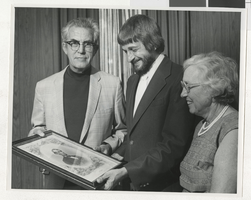
Photograph of Dr. Thomas White, Dr. Donald Baepler, and Dr. Juanita White, Las Vegas (Nev.), 1970s
Date
1970 to 1979
Archival Collection
Description
Photograph of Dr. Thomas White, Dr. Donald Baepler, and Dr. Juanita White holding a rare engraving of President Lincoln stored in Special Collections, UNLV Library, 1970s.
Image

Transcript of interview with Dr. Lonnie D. Spight by Dr. David Emerson, May 8, 2007
Date
2007-05-08
Archival Collection
Description
Dr. Lonnie D. Spight grew up in northern Colorado, earned his bachelor's degree at Colorado State University, and his PhD at University of Nevada Reno. His interest in astronomy dates from his early years on the farm in Colorado, star-gazing in the fields at night. Before coming to UNLV, Lonnie worked for the Department of Defense on scattering cross sections and explosions. Working between Los Alamos and the Test Site, he was often in Las Vegas and had met most of the physicists at the university. He was invited midterm to take over a physics class for a faculty member who had fallen ill, and was offered a job the following fall of 1970. In the seventies when Dr. Spight arrived, the physics department was located in trailers, and the university campus was mostly desert. Lonnie served as chair of the department on several occasions, and was responsible for insisting that faculty members get involved in research, no matter how tight the budget. He worked on solar energy and far-field microwave analysis, and helped set up safety standards for the new laser technology. One of Dr. Spight's interests outside of physics is a love for classical music. He was a volunteer "Deejay" for 12 years with KNPR once it got started in 1980. Meanwhile, after 37 years with UNLV Lonnie retains his enthusiasm and love for teaching. Today he teaches quantum mechanics and hopes that one day he will be able to teach a particle physics course which ties together cosmology, the beginning of the universe, fundamental cutting edge physics, quarks, gluon plasmas, and more. He has the course materials ready to go and is looking forward to many more years at UNLV.
Text
Bangle, John, 721 Fairway Dr., 801 Fairway Dr., 816 Fairway Dr., 1963
Level of Description
File
Archival Collection
Elmo C. Bruner Architectural and Real Estate Appraisal Records
To request this item in person:
Collection Number: MS-00177
Collection Name: Elmo C. Bruner Architectural and Real Estate Appraisal Records
Box/Folder: Box 09
Collection Name: Elmo C. Bruner Architectural and Real Estate Appraisal Records
Box/Folder: Box 09
Archival Component
Kilduff, Dr. Charles, 1243 Darmak Dr., 1963
Level of Description
File
Archival Collection
Elmo C. Bruner Architectural and Real Estate Appraisal Records
To request this item in person:
Collection Number: MS-00177
Collection Name: Elmo C. Bruner Architectural and Real Estate Appraisal Records
Box/Folder: Box 18
Collection Name: Elmo C. Bruner Architectural and Real Estate Appraisal Records
Box/Folder: Box 18
Archival Component
Jones, James M. Dr., 818 Campbell Dr., 1968
Level of Description
File
Archival Collection
Elmo C. Bruner Architectural and Real Estate Appraisal Records
To request this item in person:
Collection Number: MS-00177
Collection Name: Elmo C. Bruner Architectural and Real Estate Appraisal Records
Box/Folder: Box 17
Collection Name: Elmo C. Bruner Architectural and Real Estate Appraisal Records
Box/Folder: Box 17
Archival Component
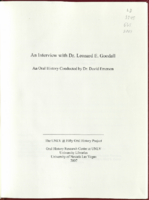
Transcript of interview with Dr. Leonard Goodall by Dr. David Emerson, March 28, 2006
Date
2006-03-28
Archival Collection
Description
Dr Leonard Goodall, former president of UNLV, comes from a unique educational background. He was born in Warrensburg, Missouri, a small town of only 6,000 souls, and received 12 years of education in the same building. After high school, he attended Central Missouri State College, which was only about 2 miles from his home. Dr. Goodall earned his master's degree at the University of Missouri, and attended the University of Illinois for his doctorate in political science. He went right into academic life, accepting a job at Arizona State in Tempe on the basis of a phone call. For five years he taught in the department of Political Science and conducted research at the institute. He subsequently moved to the University of Illinois Chicago as instructor and then chancellor (four years), and from there to the University of Michigan Dearborn as chancellor (eight years). In 1979, Leonard accepted a position as president of UNLV. He oversaw the development of the College of Engineering, helped create the UNLV Foundation, and made a number of appointments, such as athletic director, any number of deanships, and academic vice president of student affairs. After his presidency, Dr. Goodall returned to his professorship in public administration and served on many campus committees. He phased his retirement over several years, and was completely out in 2002. Today, Leonard continues to serve on graduate committees for UNLV, and works on the search committee to find a new president.
Text
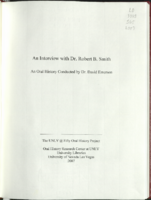
Transcript of interview with Dr. Robert B. Smith by Dr. David Emerson, June 13, 2006
Date
2006-06-13
Archival Collection
Description
Dr. Robert Bruce Smith was born in Philadelphia and spent his first two years in New Jersey, but thinks of California as home. His father's calling as a minister had taken them back east, and after his seminary training they returned to Los Angeles, followed by a five year stint in Oregon before returning to Vista, California. After high school graduation, Bob left home to attend Wheaton College in Illinois, a small Protestant school. He met his wife there and after completing his Bachelor's in chemistry they were off to Berkeley, where he completed his PhD in three years. Along the way, Dr. Smith had worked for G.D. Searle in Skokie, Illinois, and at first thought that this was his calling. His semester as a Teaching Assistant, however, convinced him that the academic life was what he wanted. Late in 1961, he learned of a job opening at the Southern Regional Division of the University of Nevada (now UNLV), interviewed with Malcolm Graham who was recruiting in San Francisco, and flew to Las Vegas to see the campus for himself. It consisted of three and a half buildings surrounded by desert. Robert's thesis director encouraged him to take the job at this new, very small college, so he and his wife drove to Las Vegas to find an apartment. They fell in love with the area and he started at UNLV as assistant professor of chemistry. He did work in organic chemistry and served as chair of the Department of Physical Sciences, as it was then called. In 1968 the department was turned into a college, and Bob became the dean of the College of Science and Mathematics. He held this position for 12 years. In 1980, Dr. Smith accepted an offer from Weber State College in Ogden, Utah, and served there as Academic Vice President (later Provost) until his retirement in 1998. He recalls with great clarity the people, changes, and events that he was involved with during the early years at UNLV. Today he and his wife enjoy their retirement in their favorite spot in the San Jacinto Mountains.
Text
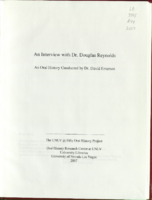
Transcript of interview with Dr. Douglas Reynolds by Dr. David Emerson, June 16, 2006
Date
2006-06-16
Archival Collection
Description
Professor Douglas Reynolds joined the engineering faculty in 1983. His credentials include a B.S. from Michigan State, M.S in mechanical engineering from Purdue, and a PhD in the same field, also from Purdue. Dr. Reynolds' work experience includes an assistant professorship at University of Texas a Austin (architectural engineering), associate professor in mechanical engineering at University of Pittsburgh, and a stint of industrial experience working for Caterpillar Tractor Company. He also worked as an acoustical consultant in Dallas, Texas. When interviewed at UNLV, Doug sensed that this was an opportunity to get in on the ground floor of a new engineering program and really have an impact on its development. He worked on the Engineering Advisory Committee and was given the task to justify the existence and growth of the engineering program at UNLV. He presented a report which documented the size and cost of the engineering building, and that report led to the existence of the building that can be found on campus today. With the building under construction, the engineering program itself needed accreditation with the American Board of Engineering and Technology. Dr Reynolds was responsible for documenting past, present, and future plans for the department courses and degrees. He also had to document a legitimate student graduation in order to apply tor accreditation. All this was accomplished in a short time, and the school received a very high evaluation. Dr. Reynolds' primary specialty is mechanical vibration and acoustics. He teaches machine design, kinematics and dynamics, and courses in mechanical vibration and acoustics. He wrote a textbook in the early 80's, "Engineering Principles of Acoustics." The updated revision will be completed soon, and he is also writing a new text entitled "Engineering Principles of Vibration". Douglas is chief U.S. delegate and chairman of the U.S. technical advisory group for ISO (International Standards Organization). He logs thousands of air miles every year on trips that are basically directed to research, bringing in research dollars, or are related to the standards work he does. His efforts on such a broad scale bring the UNLV engineering school national and worldwide exposure.
Text
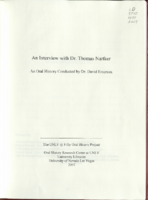
Transcript of interview with Dr. Thomas Nartker by Dr. David Emerson, November 13, 2006
Date
2006-11-13
Archival Collection
Description
Thomas Nartker was born and raised in Dayton, Ohio, and most of his family, including three brothers and a sister, still live there. He attended grade school and high school there, and then attended the University of Dayton. He majored in chemical engineering, following the example of his father, who had a degree in electrical engineering. By the time he was a sophomore in college, he was six-foot nine and had spent some time on the basketball court, but when asked to play his senior year at U. of D., he declined. He had already been accepted for graduate study at the University of Tennessee. Thomas finished all course work and research on his master's in one year, everything but the thesis. He interviewed over 30 companies before he graduated, but an interview with DuPont in Delaware made him think about the value of a PhD in his line of work. He applied and was accepted at Texas A&M. He worked with Dave Billingsley, who was the resident computer expert, and Dave showed him how to process all the data he had collected for his master's thesis on the IBM 650. Tom had found a new passion. Within a year, Tom was working as an assistant in the data processing center at Texas A&M, and was also the teaching assistant for the computer programming class. After completing his PhD, which took 6 years, Thomas began interviewing again. He accepted a position at New Mexico Institute of Mining and Technology (NMIMT) as assistant professor of mathematics and director of the computing center. He left NMIMT in 1981 and took a job with Shell Oil Company, which included 5 years as a visiting staff member at Los Alamos. In 1985 he met John Werth, who ultimately offered Tom a job at UNLV. Tom made the move to Las Vegas in July of 1985. Dr. Nartket and Dr. Taghva started the UNLV Information Science Research Institute and did experimental research on Optical Character Recognition (OCR) for the Department of Energy (DOE). They invented many metrics never seen before, including a metric called Nonstop Word Accuracy. Today UNLV is known worldwide for being the premier center for doing research in OCR technology. Thomas is in his seventies today and continues with his research and teaching because he loves it. He has enjoyed over two decades at UNLV and finds it a rewarding and intellectual place to be. He considers this university to be one of the most exciting in the country as it grows in research and service.
Text
Pagination
Refine my results
Content Type
Creator or Contributor
Subject
Archival Collection
Digital Project
Resource Type
Year
Material Type
Place
Language
Records Classification
